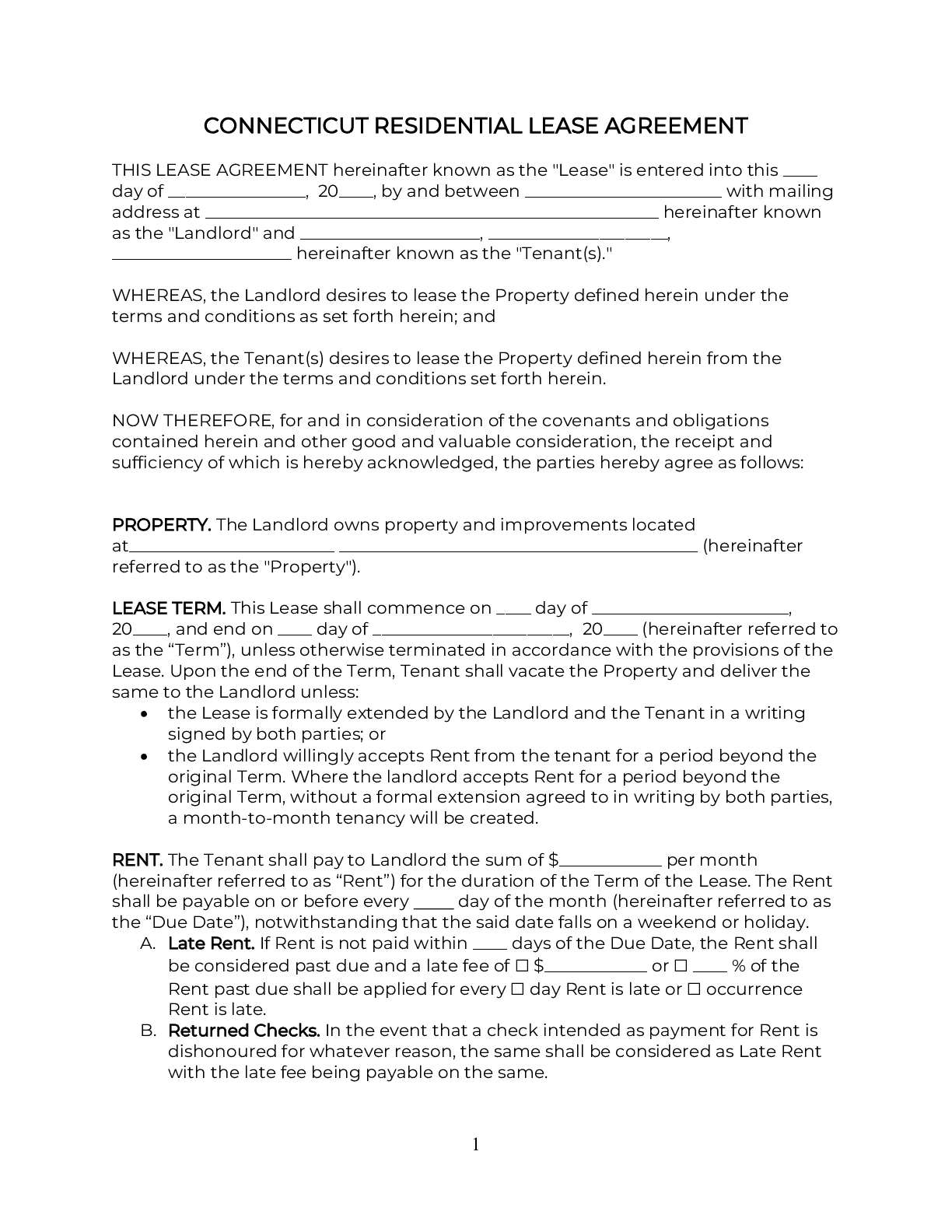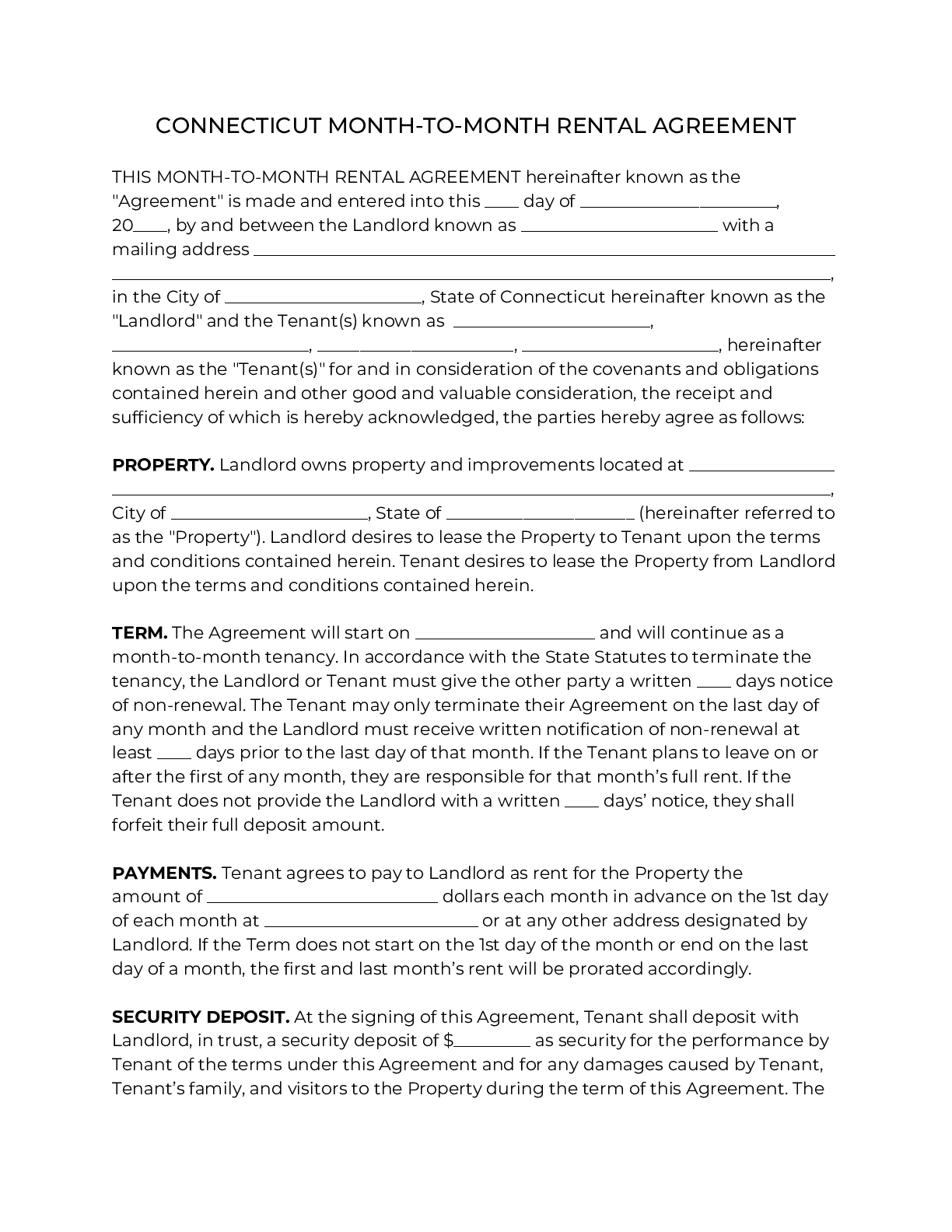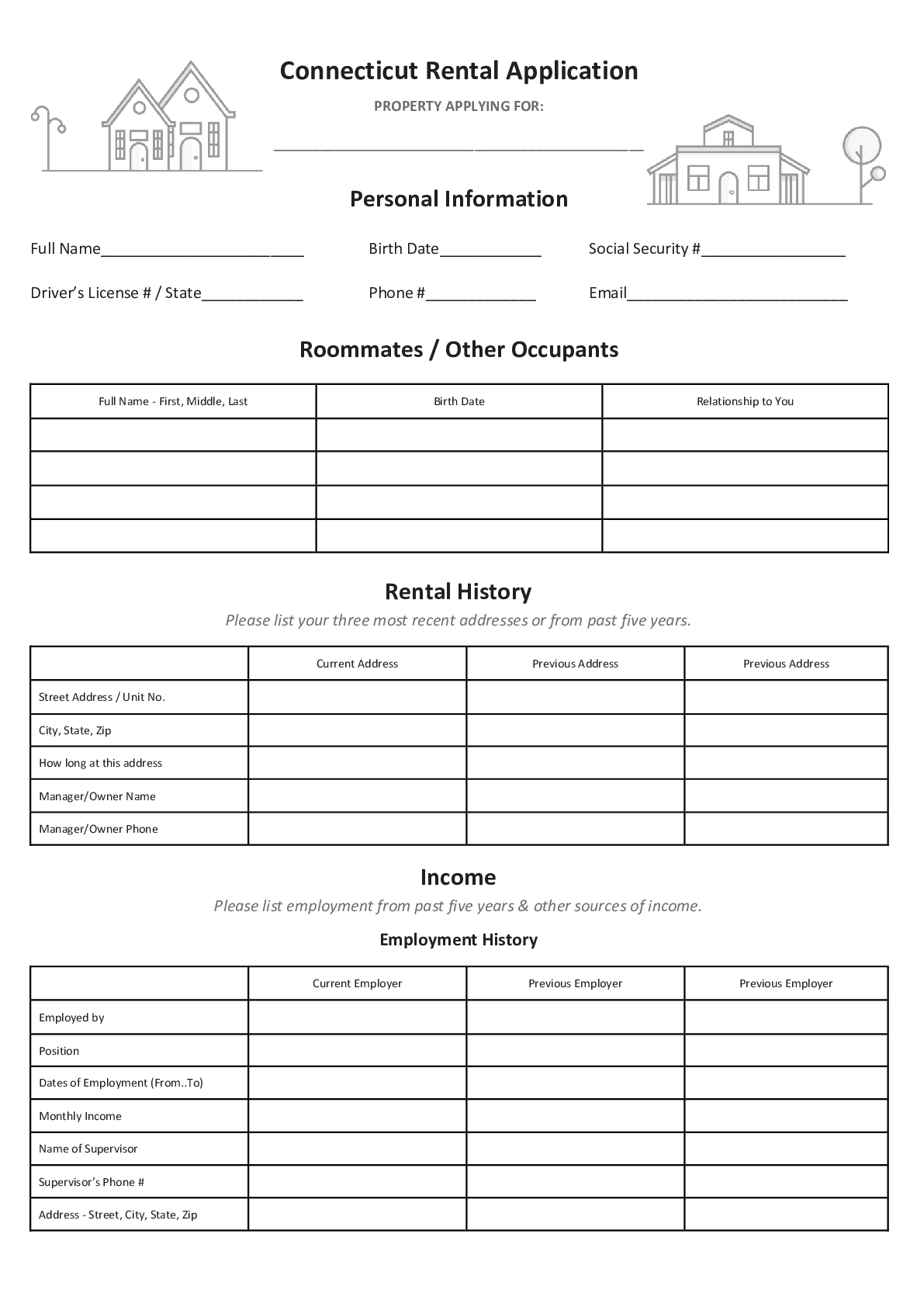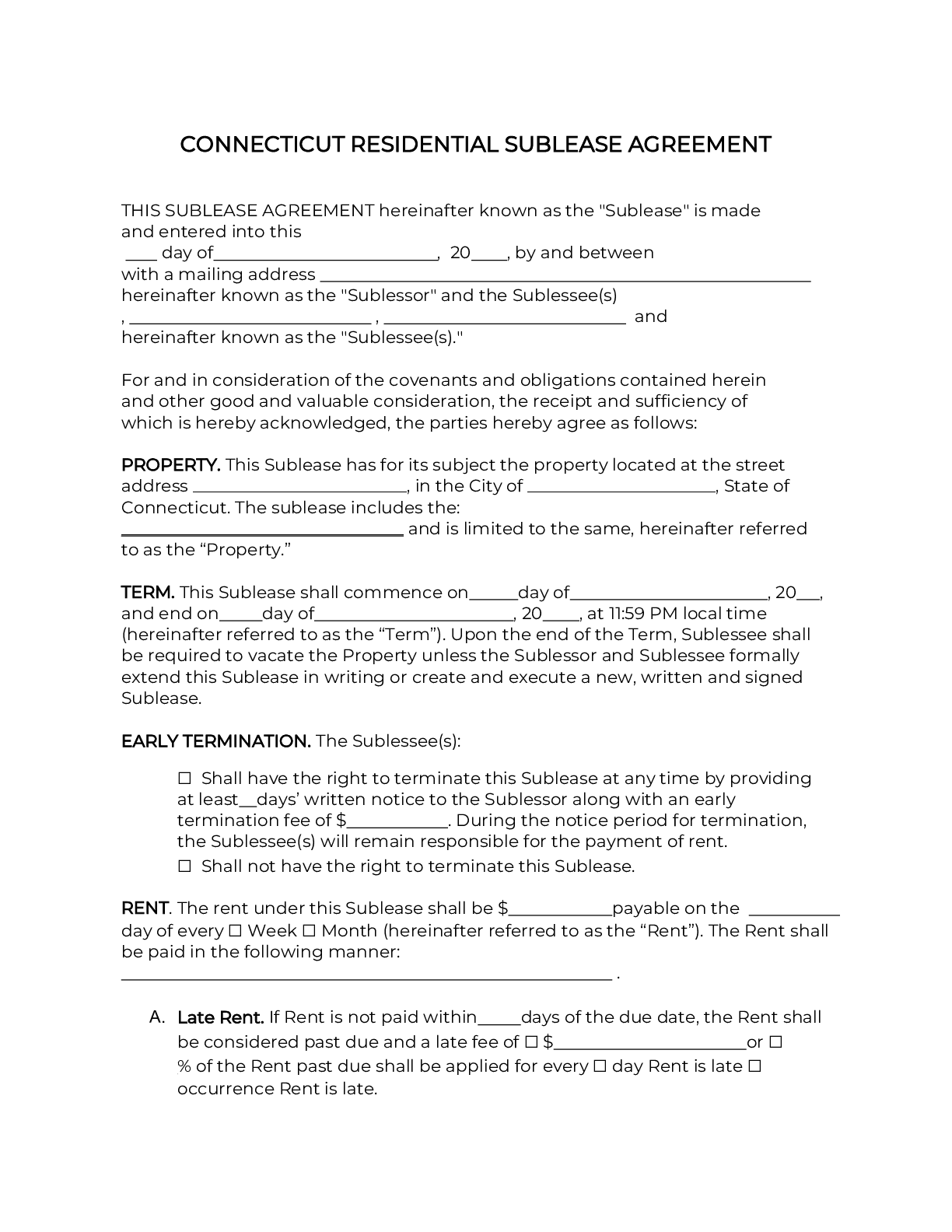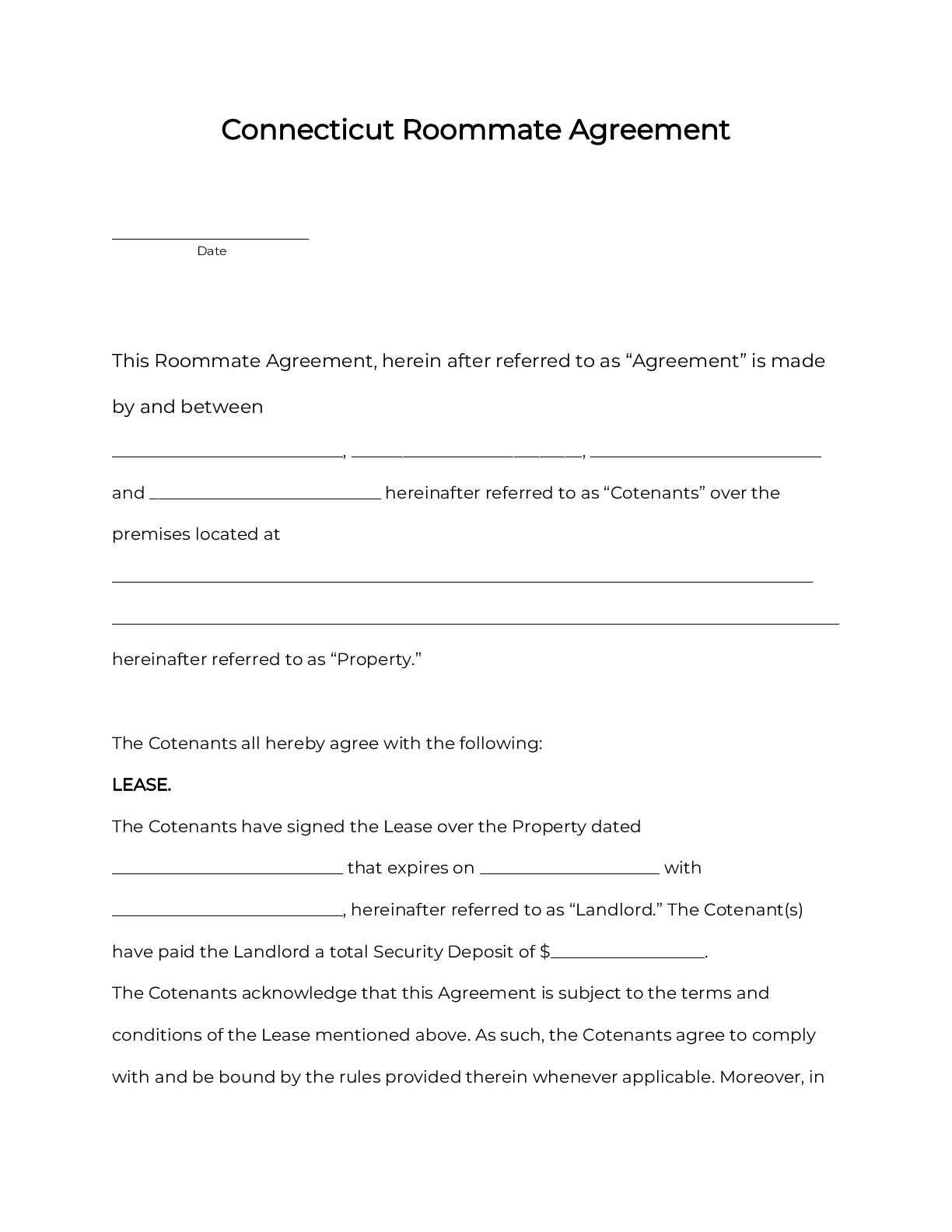A Connecticut rental agreement is a legal contract between a landlord overseeing a rental property and a tenant using the property. California landlord-tenant law governs and regulates these agreements.
Connecticut Rental Agreement Types
A Connecticut roommate agreement is a legal contract between two or more people (“co-tenants”) who share a rental property according to rules they set, including for things like splitting the rent. This agreement binds the co-tenants living together, and doesn’t include the landlord.
Common Residential Rental Agreements in Connecticut
- Connecticut Department of Housing Unite CT Rental Terms Form – This form is for tenants in a hotel or motel, or on an oral lease. It helps formalize and document some basic rental arrangements. The form covers the rental term, rent payment, and additional tenant expenses.
Connecticut Required Residential Lease Disclosures
- Landlord’s Name and Address (required for all leases) – Connecticut landlords must give the tenant their name and address, or that of their authorized agent. This ensures smooth communication of legal notice. In most cases, landlords also include phone number and email address, as applicable.
- Move-In Checklist (required for all leases) – Landlords must provide a move-in checklist to document existing property damage before the tenant moves in. This ensures accurate deductions from the security deposit upon move-out.
- Notice of Elderly and Disabled Tenant Rights (required for all leases) – Landlords must provide a Housing Commission notice of special protections against eviction and rent increases. These protections are for tenants over age 62, disabled tenants, and family members who live with them.
- Common Interest Community Notice (required for some leases) – Common interest communities in Connecticut must provide notice in the lease about potential community expectations.
- Operative Fire Sprinkler System Notice (required for some leases) – Some Connecticut properties require a fire sprinkler system. If they do, they must be rented together with a statement that the system is installed and in good condition. The notice must be in 12-point uniform font.
- Bed Bug Disclosure (required for all leases) – Connecticut landlords must disclose any known or suspected infestation in an area which touches the rental property. The tenant also has a right to get the property’s bed bug inspection history upon request.
- Lead-Based Paint Disclosures (required for some leases) – Landlords must provide an EPA-approved disclosure and informational pamphlet to tenants renting any property built before 1978.
To learn more about required disclosures in Connecticut, click here.
Connecticut Landlord Tenant Laws
- Warranty of Habitability – Connecticut landlords can only rent out habitable property. This means providing certain basic health and safety features like heat, plumbing, and electricity. Landlords must repair any issues within 15 days after proper notice from the tenant. Failure to repair lets a tenant sue the landlord or end the lease. Tenants aren’t allowed to withhold rent, or to repair and deduct in most cases.
- Evictions – Connecticut landlords may evict for rent default, lease violations, or illegal acts, among other things. Before filing eviction, landlords must serve tenants with prior notice of three to 30 days, depending on the eviction type and the tenant’s CARES Act status. State law has extra eviction protections for elderly or disabled tenants and their families. Most evictions in Connecticut take a month or more.
- Security Deposits – Connecticut caps security deposits at a maximum of two months’ rent, for most leases. For tenants over age 62, this is instead one month’s rent. When the lease ends, a landlord must return any unused portion of a tenant’s security deposit. The time limit is within 21 days of move-out, or within 15 days of getting the forwarding address.
- Lease Termination – Connecticut lets tenants break a month-to-month lease with three days of advance notice. Terminating a fixed-term lease early requires (in most cases) active military duty, landlord harassment, uninhabitable property, or domestic abuse.
- Rent Increases and Fees – Connecticut law requires a default 45 days of notice a rent increase. For leases month-to-month or shorter, this is instead notice equal to the lease term. The state lets elderly and disabled tenants object to unfair rent increases and have the fair rent commission review. Late rent fees are capped at $5/day up to a maximum $50, or 5% of the rental payment. Returned check fees have a $20 per check limit.
- Landlord Entry – Connecticut landlords may enter rental property for reasonable business purposes like maintenance, inspections, and property showings. Before entering, they must provide reasonable advance notice (at least 24 hours as a rule of thumb), except for emergencies.
- Settling Legal Disputes – Connecticut allows small claims courts to hear landlord-tenant disputes, if the amount in controversy is under $5,000. In some parts of the state, disputes may be heard by a local Housing Session instead.
To learn more about landlord tenant laws in Connecticut, click here.
Sources
- 1 Conn. Gen. Stat. § 47a-7c
-
(a) As used in this section, “walk-through” means a joint physical inspection of the dwelling unit by the landlord and the tenant, or their designees, for the purpose of noting and listing any observed conditions within the dwelling unit. On and after January 1, 2024, upon or after the entry into a rental agreement but prior to the tenant’s occupancy of a dwelling unit, a landlord shall offer such tenant the opportunity to conduct a walk-through of the dwelling unit. If the tenant requests such a walk-through, the landlord and tenant, or their designees, shall use a copy of the preoccupancy walk-through checklist prepared by the Commissioner of Housing under subsection (c) of this section. The landlord and the tenant, or their designees, shall specifically note on the walk-through checklist any existing conditions, defects or damages to the dwelling unit present at the time of the walk-through. After the walk-through, the landlord and the tenant, or their designees, shall sign duplicate copies of the walkthrough checklist and each shall receive a copy.
(b) Upon the tenant’s vacating of the dwelling unit, the landlord may not retain any part of the security deposit collected under chapter 831 of the general statutes or seek payment from the tenant for any condition, defect or damage that was noted in the preoccupancy walk-through checklist. Such walk-through checklist shall be admissible, subject to the rules of evidence, but shall not be conclusive, as evidence of the condition of the dwelling unit at the beginning of a tenant’s occupancy in any administrative or judicial proceeding.
(c) Not later than December 1, 2023, the Commissioner of Housing shall (1) prepare a standardized preoccupancy walk-through checklist for any landlord and tenant to use to document the condition of any dwelling unit during a preoccupancy walk-through under subsection (a) of this section, and (2) make such checklist available on the Department of Housing’s Internet web site.
(d) The provisions of this section shall not apply to any tenancy under a rental agreement entered into prior to January 1, 2024.
Source Link - 2 Conn. Gen. Stat. § 47a-23c(e)
-
(1) On and after January 1, 2024, whenever a dwelling unit located in a building or complex consisting of five or more separate dwelling units or in a mobile manufactured home park is rented to, or a rental agreement is entered into or renewed with, a tenant, the landlord of such dwelling unit or such landlord’s agent shall provide such tenant with written notice of the provisions of subsections (b) and (c) of this section in a form as described in subdivision (2) of this subsection.
(2) Not later than December 1, 2023, the Commissioner of Housing shall create a notice to be used by landlords, pursuant to subdivision (1) of this subsection, to inform tenants of the rights provided to protected tenants under subsections (b) and (c) of this section. Such notice shall be a one-page, plain-language summary of such rights and shall be available in both English and Spanish. Not later than December 1, 2023, such notice shall be posted on the Department of Housing’s Internet web site.
(3) Not later than December 1, 2028, the commissioner shall (A) translate the notice required under subdivision (2) of this subsection into the five most commonly spoken languages in the state, as determined by the commissioner, and (B) post such translations on the Department of Housing’s Internet web site not later than December 1, 2028.
Source Link - 3 Nwagwu v. Dawkins, No. BPHCV215004438S, 2021 WL 2775065, at *7 (Conn. Super. Ct. Mar. 2, 2021)
-
This matter is dismissed as a 30-day notice under the Cares Act was not provided to the tenant.
- 4 Conn. Gen. Stat. 47a-23c(a)(1) & (b)(1)
-
(a)(1) Except as provided in subdivision (2) of this subsection, this section applies to any tenant who resides in a building or complex consisting of five or more separate dwelling units or who resides in a mobile manufactured home park and who is either:
(A) Sixty-two years of age or older, or whose spouse, sibling, parent or grandparent is sixty-two years of age or older and permanently resides with that tenant, or
(B) a person with a physical or mental disability, as defined in subdivision (8) of section 46a-64b, or whose spouse, sibling, child, parent or grandparent is a person with a physical or mental disability who permanently resides with that tenant, but only if such disability can be expected to result in death or to last for a continuous period of at least twelve months.
…
(b) (1) No landlord may bring an action of summary process or other action to dispossess a tenant described in subsection (a) of this section except for one or more of the following reasons:
(A) Nonpayment of rent;
(B) refusal to agree to a fair and equitable rent increase, as defined in subsection (c) of this section;
(C) material noncompliance with section 47a-11 or subsection (b) of section 21-82, which materially affects the health and safety of the other tenants or which materially affects the physical condition of the premises;
(D) voiding of the rental agreement pursuant to section 47a-31, or material noncompliance with the rental agreement;
(E) material noncompliance with the rules and regulations of the landlord adopted in accordance with section 47a-9 or 21-70;
(F) permanent removal by the landlord of the dwelling unit of such tenant from the housing market; or
(G) bona fide intention by the landlord to use such dwelling unit as his principal residence.
Source Link - 5 Conn. Gen. Stat. § 47a-21(d)(2)
-
Source Link
(2) Upon termination of a tenancy, any tenant may notify the landlord in writing of such tenant’s forwarding address. Not later than twenty-one days after termination of a tenancy or fifteen days after receiving written notification of such tenant’s forwarding address, whichever is later, each landlord other than a rent receiver shall deliver to the tenant or former tenant at such forwarding address either (A) the full amount of the security deposit paid by such tenant plus accrued interest, or (B) the balance of such security deposit and accrued interest after deduction for any damages suffered by such landlord by reason of such tenant’s failure to comply with such tenant’s obligations, together with a written statement itemizing the nature and amount of such damages. Any landlord who violates any provision of this subsection shall be liable for twice the amount of any security deposit paid by such tenant, except that, if the only violation is the failure to deliver the accrued interest, such landlord shall be liable for ten dollars or twice the amount of the accrued interest, whichever is greater.
- 6 Conn. Pub. Act No. 24-143 sec. 17 (2024)
-
As of April 2025, the Connecticut state government has not yet updated its statutes to reflect a 2024 change establishing a 45-day requirement. The new statute likely will be designated Conn. Gen. Stat. § 47a-47 upon update:
=====
Sec. 17. (NEW) (Effective October 1, 2024, and applicable to rental agreements entered into, renewed or extended on or after October 1, 2024) No rent increase for a dwelling unit shall be effective unless the landlord has given the tenant of such dwelling unit written notice of the proposed increase not less than forty-five days before the day on which the increase is proposed to take effect, except in the case of a lease with a term of one month or less, such notice shall be given a number of days equivalent to the length of a full term of such lease. A tenant’s failure to respond to such notice shall not constitute the tenant’s agreement to such proposed increase. Nothing in this section shall be construed to (1) allow a landlord to increase the rent during the term of a rental agreement, or (2) alter any notice requirements concerning increases in rent imposed by federal law.
Source Link - 7 Conn. Gen. Stat. § 47a-15a(b)
-
Source Link
If a rental agreement contains a valid written agreement to pay a late charge in accordance with subsection (a) of section 47a-4, a landlord may assess a tenant such a late charge on a rent payment made subsequent to the grace period in accordance with this section. Such late charge may not exceed the lesser of (1) five dollars per day, up to a maximum of fifty dollars, or (2) five per cent of the delinquent rent payment or, in the case of a rental agreement paid in whole or in part by a governmental or charitable entity, five per cent of the tenant’s share of the delinquent rent payment. The landlord may not assess more than one late charge upon a delinquent rent payment, regardless of how long the rent remains unpaid.
- 8 Conn. Gen. Stat. § 52-565a(i)
-
Notwithstanding the provisions of this section, in the case of a drawer who negotiates a check which is dishonored, the payee or its assignee may impose on the drawer a service charge of up to twenty dollars, provided, no such service charge may be imposed if (1) the drawer has stopped payment on the check, (2) the check was stolen, or (3) the drawer has raised a reasonable defense with respect to the validity of the underlying debt. The drawer shall not be liable under this subsection for more than one such service charge for each dishonored check.
Source Link




